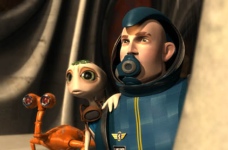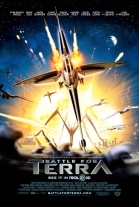The Battle for Terra
|  What if there was a battle to save the human race and no one showed up? That is basically what happened with the computer-animated sci-fi fable The Battle for Terra, which opened in theaters last weekend beneath the shadow of the franchise juggernaut X-Men Origins: Wolverine. Despite the fact that the film features a bevy of A-list Hollywood voice talent and impressive 3-D action, virtually no one went to see it, which is a real shame because it is an intriguing and frequently exciting experiment in using 3-D computer-generated animation for serious-minded entertainment. The problem with The Battle for Terra may be that it falls right in between the cracks of the older and younger demographics, with older audiences shunning it because it’s animated (and therefore assumed to be kiddie fare) and younger audiences skipping it because it’s a little too dark for pure summer escapism. What if there was a battle to save the human race and no one showed up? That is basically what happened with the computer-animated sci-fi fable The Battle for Terra, which opened in theaters last weekend beneath the shadow of the franchise juggernaut X-Men Origins: Wolverine. Despite the fact that the film features a bevy of A-list Hollywood voice talent and impressive 3-D action, virtually no one went to see it, which is a real shame because it is an intriguing and frequently exciting experiment in using 3-D computer-generated animation for serious-minded entertainment. The problem with The Battle for Terra may be that it falls right in between the cracks of the older and younger demographics, with older audiences shunning it because it’s animated (and therefore assumed to be kiddie fare) and younger audiences skipping it because it’s a little too dark for pure summer escapism.The story takes place in the distant future when the human race has depleted all the resources on Earth and, after having colonized and terraformed two other planets, went to war against themselves and destroyed all three worlds. Thus, the only remnant of humanity is a huge, deep-space ark that has been traveling for generations to find a sustainable planet. The film’s trick, though, is that the story is not told from the human perspective, but rather from the perspective of the Terrians, the native residents of the planet that humankind zeroes in on and intends to make their new home. This means, of course, killing (or, more specifically, exterminating) the Terrians because the atmosphere in which they are able to survive must be altered for human survival. Thus, we have two species vying for the same planet, and the film purposefully baits and challenges our allegiance by putting us in the position of seeing that the human race is essentially wrong in its endeavor, but only because it no choice because the ark is falling apart and if humans don’t colonize a new planet soon, they will all die. The Terrians, who look like moist-eyed Muppet fishheads on top of floating tadpole bodies, are presented as a peaceful species who are nonetheless technologically sophisticated. They live in harmony with the other creatures on their planet, which include gentle hummingbird-bird like creatures and giant sky whales. The main character is Mala (Evan Rachel Wood), a girl who we first meet zooming through the air on a flying contraption with her best friend, Senn (Justin Long). When the humans eventually invade their planet, she befriends a crashed pilot named Jim Stanton (Luke Wilson), and his robot companion, Giddy (David Cross), who looks like WALL•E crossed with an orange cat and sound like a benevolent version of 2001’s HAL. Jim represents fundamental human decency, unlike General Hemmer (Brian Cox), a hawkish military leader who leads a coup to cut short any debate about the ethics of taking over another planet in favor of decisive action. As it turns out, the Terrians are not quite the peaceful species they first appeared to be; that is, their harmonious existence is shown to be the result of a conscious choice to reject violence and warfare, rather than an inherent condition. At the same time, though, as one Terrian puts it, even a peaceful society must defend itself, and when the human warships come down from the skies, they are met with fierce resistance. The allegorical implications of The Battle for Terra (written by Disney vet Evan Spiliotopoulos from a story originally concocted by digital FX guru-turned-director Aristomenis Tsirbas) are obvious, although never quite as heavy-handed as they could be. The ecological issues, which were also reflected in last summer’s WALL•E (2008), have become a staple of recent science fiction, but what intrigued me more was the story’s reflection of human violence and its various justifications. It doesn’t take a stretch of the imagination to see how the human race’s need to colonize Terra reflects numerous atrocities throughout history, including slavery, invasion, and the forced removal of native peoples by “superior” societies. However, Tsirbas keeps the speechifying to a minimum and allows the film’s moral message to grow out of the characters’ emotional conflicts, not to mention the conflicted responses we have to our torn allegiance. The film wraps up with a relatively believable happy ending, but not before there has been a significant amount of death and sacrifice, reminding us that, even in the best of situations, nothing is easy. Copyright ©2009 James Kendrick Thoughts? E-mail James Kendrick All images copyright © Lionsgate |
Overall Rating: 

 (3)
(3)


